Posteroanterior Chest X-ray Image Classification with a Multilayer 1D Convolutional Neural Network-Based Classifier for Cardiomegaly Level Screening
Abstract
1. Introduction
2. Materials and Methods
2.1. Experimental Setup
2.2. CXR Image Collection and Preprocessing
2.3. Multilayer 1D Convolutional Neural Network Design
2.3.1. Feature Extraction Layer with Two-Round 1D Convolutional Processes
2.3.2. Classification Layer with a GRA-Based Classifier
2.4. Classifier’s Performance Validation
3. Experimental Results and Discussion
3.1. Experimental Setup and Testing Results
3.2. Discussion
- the feature signals could be enhanced by two-round 1D convolutional processes;
- the different cardiomegaly levels could be quantified by two-round 1D convolutional processes which could be used to separate normal from mild/moderate or severe levels (as seen in Figure 7);
- the dimension of feature signals could also be reduced by 1D downsampling process to address the overfitting problems;
- the CRA-based classifier performs classification task with straightforward mathematic operations without complex iteration computations and learning algorithm requirement.
4. Conclusions
Author Contributions
Funding
Institutional Review Board Statement
Informed Consent Statement
Data Availability Statement
Conflicts of Interest
References
- Schlett, C.L.; Kwait, D.C.; Mahabadi, A.A.; Bamberg, F.; O’Donnell, C.J.; Fox, C.S.; Hoffmann, U. Simple area-based measurement for multidetector computed tomography to predict left ventricular size. Eur. Radiol. 2010, 20, 1590–1596. [Google Scholar] [CrossRef] [PubMed]
- Centurión, O.A.; Scavenius, K.E.; Miño, L.M.; Sequeira, O.R. Evaluating cardiomegaly by radiological cardiothoracic ratio as compared to conventional echocardiography. J. Cardiol. Curr. Res. 2017, 9, 00319. [Google Scholar]
- Hota, P.; Simpson, S. Going beyond cardiomegaly: Evaluation of cardiac chamber enlargement at non-electrocardiographically gated multidetector CT: Current techniques, limitations, and clinical implications. Radiol. Cardiothorac. Imaging 2019, 1, e180024. [Google Scholar] [CrossRef]
- Malik, S.B.; Kwan, D.; Shah, A.B.; Hsu, J.Y. The Right Atrium: Gateway to the Heart—Anatomic and Pathologic Imaging Findings. Radiographics 2015, 35, 14–31. [Google Scholar] [CrossRef] [PubMed]
- Nation Institutes of Health (NIH). Clinical Center, Images Are Available via Box. 2019. Available online: https://Nihcc.app.box.com/v/ChestXray-NIHCC (accessed on 1 June 2018).
- Wang, X.; Peng, Y.; Lu, L.; Lu, Z.; Bagheri, M.; Summers, R.M. ChestX-ray8: Hospital-scale chest X-ray database and benchmarks on weakly-supervised classification and localization of common thorax diseases. In Proceedings of the 2017 IEEE Conference on Computer Vision and Pattern Recognition (CVPR), Honolulu, HI, USA, 21–26 July 2017. [Google Scholar]
- Japanese Society of Radiological Technology. Digital Image Database-JSRT Database. 2004. Available online: http://db.jsrt.or.jp/eng.php (accessed on 1 February 2021).
- Shiraishi, J.; Katsuragawa, S.; Ikezoe, J.; Matsumoto, T.; Kobayashi, T.; Komatsu, K.-I.; Matsui, M.; Fujita, H.; Kodera, Y.; Doi, K. Development of a digital image database for chest radiographs with and without a lung nodule: Receiver operating characteristic analysis of radiologists’ detection of pulmonary nodules. Amer. J. Roentgenol. 2000, 174, 71–74. [Google Scholar] [CrossRef] [PubMed]
- Han, W.K.; Zaki, N.M.; Ali, L. Intelligent Pneumonia Identification From Chest X-rays: A Systematic Literature Review. IEEE Access 2021, 9, 51747–51771. [Google Scholar]
- Jaeger, S.; Candemir, S.; Antani, S.; Wáng, Y.-X.; Lu, P.-X.; Thoma, G. Two public chest X-ray datasets for computer-aided screening of pulmonary diseases. Quant. Imaging Med. Surg. 2014, 4, 475–477. [Google Scholar]
- Quinton, S.; Ker, J.; Rheeder, P.; Deffur, A. The reliability of chest radiographs in predicting left atrial enlargement. Cardiovasc. J. Afr. 2010, 21, 274–279. [Google Scholar] [CrossRef][Green Version]
- Sanchita, S.-P.; Sehrish, J.; Zilla, H. An atypical case of dysphagia: Left atrial enlargement. Am. J. Gastroenterol. 2018, 113, S1013–S1014. [Google Scholar]
- Li, Z.; Hou, Z.; Chen, C.; Hao, Z.; An, Y.; Liang, S.; Lu, B. Automatic Cardiothoracic Ratio Calculation with Deep Learning. IEEE Access 2019, 7, 37749–37756. [Google Scholar] [CrossRef]
- Simkus, P.; Gimeno, M.G.; Banisauskaite, A.; Noreikaite, J.; McCreavy, D.; Penha, D.; Arzanauskaite, M. Limitations of cardiothoracic ratio derived from chest radiographs to predict real heart size: Comparison with magnetic resonance imaging. Insights Imaging 2021, 12, 158. [Google Scholar] [CrossRef] [PubMed]
- Truszkiewicz, K.; Poręba, R.; Gać, P. Radiological Cardiothoracic Ratio in Evidence-Based Medicine. J. Clin. Med. 2021, 10, 2016. [Google Scholar] [CrossRef] [PubMed]
- Lin, C.-H.; Wu, J.-X.; Li, C.-M.; Chen, P.-Y.; Pai, N.-S.; Kuo, Y.-C. Enhancement of Chest X-ray Images to Improve Screening Accuracy Rate Using Iterated Function System and Multilayer Fractional-Order Machine Learning Classifier. IEEE Photon. J. 2020, 12, 1–18. [Google Scholar] [CrossRef]
- Lu, J.-Y.; Lee, P.-Y.; Huang, C.-C. Improving Image Quality for Single-Angle Plane Wave Ultrasound Imaging with Convolutional Neural Network Beamformer. IEEE Trans. Ultrason. Ferroelectr. Freq. Control 2022, 69, 1326–1336. [Google Scholar] [CrossRef] [PubMed]
- Shelhamer, E.; Long, J.; Darrell, T. Fully convolutional networks for semantic segmentation. IEEE Trans. Pattern Anal. Mach. Intell. 2017, 39, 640–651. [Google Scholar] [CrossRef] [PubMed]
- Que, Q.; Tang, Z.; Wang, R.; Zeng, Z.; Wang, J.; Chua, M.; Gee, T.S.; Yang, X.; Veeravalli, B. CardioXNet: Automated detection for cardiomegaly based on deep learning. In Proceedings of the 2018 40th Annual International Conference of the IEEE Engineering in Medicine and Biology Society (EMBC), Honolulu, HI, USA, 18–21 July 2018; pp. 612–615. [Google Scholar]
- Rajpurkar, P.; Irvin, J.; Zhu, K.; Yang, B.; Mehta, H.; Duan, T.; Ding, D.; Bagul, A.; Langlotz, C.; Shpanskaya, K.; et al. CheXNet: Radiologist-level pneumonia detection on chest X-rays with deep learning. arXiv 2017, arXiv:1711.05225. [Google Scholar]
- Mortazi, A.; Rashed, K.; Kawal, R.; Jeremy, B.; Ulas, B. CardiacNET: Segmentation of left atrium and proximal pulmonary veins from MRI using multi-view CNN. In Proceedings of the International Conference on Medical Image Computing and Computer-Assisted Intervention, Quebec City, QC, Canada, 11–13 September 2017; pp. 377–385. [Google Scholar]
- He, K.; Zhang, X.; Ren, S.; Sun, J. Deep residual learning for image recognition. In Proceedings of the 2016 IEEE Conference on Computer Vision and Pattern Recognition (CVPR), Las Vegas, NV, USA, 27–30 June 2016; Volume 1, pp. 770–778. [Google Scholar]
- Drozdzal, M.; Vorontsov, E.; Chartrand, G.; Kadoury, S.; Pal, C. The Importance of Skip Connections in Bio-Medical Image Segmentation; Lecture Notes in Computer Science; Springer International Publishing AG: Basel, Switzerland, 2016. [Google Scholar]
- Ullah, A.; Anwar, S.M.; Bilal, M.; Mehmood, R.M. Classification of arrhythmia by using deep learning with 2-D ECG spectral image representation. Remote Sens. 2020, 12, 1685. [Google Scholar] [CrossRef]
- Kiranyaz, S.; Avci, O.; Abdeljaber, O.; Ince, T.; Gabbouj, M.; Inman, D.J. 1D convolutional neural networks and applications: A survey. Mech. Syst. Signal Processing 2021, 151, 107398. [Google Scholar] [CrossRef]
- Wu, Y.; Yang, F.; Liu, Y.; Zha, X.; Yuan, S. A comparison of 1-D and 2-D deep convolutional neural networks in ECG classification. In Proceedings of the 2018 40th Annual International Conference of the IEEE Engineering in Medicine and Biology Society, Honolulu, HI, USA, 17–21 July 2018. [Google Scholar]
- Lin, C.-H.; Wu, J.-X.; Kan, C.-D.; Chen, P.-Y.; Chen, W.-L. Arteriovenous shunt stenosis assessment based on empirical mode decomposition and 1D convolutional neural network: Clinical trial stage. Biomed. Signal Processing Control 2021, 66, 102461. [Google Scholar] [CrossRef]
- Chen, P.-Y.; Sun, Z.-L.; Wu, J.-X.; Pai, C.C.; Li, C.-M.; Lin, C.-H.; Pai, N.-S. Photoplethysmography analysis with Duffing–Holmes self-synchronization dynamic errors and 1D CNN-based classifier for upper extremity vascular disease screening. Processes 2021, 9, 2093. [Google Scholar] [CrossRef]
- Chang, H.-Y.; Yeh, C.-Y.; Lee, C.-T.; Lin, C.-C. A sleep apnea detection system based on a one-dimensional deep convolution neural network model using single-lead electrocardiogram. Sensors 2020, 20, 4157. [Google Scholar] [CrossRef] [PubMed]
- Syntax: Conv, 1994–2021. Available online: https://www.mathworks.com/help/matlab/ref/conv.html (accessed on 1 January 2021).
- Sequence-to-Sequence Classification Using 1-D Convolutions, 1994–2021. Available online: https://www.mathworks.com/help/deeplearning/ug/sequence-to-sequence-classification-using-1-d-convolutions.html (accessed on 1 January 2021).
- Wua, Y.; Zhou, F.; Kong, J. Innovative design approach for product design based on TRIZ, AD, fuzzy and Grey relational analysis. Comput. Ind. Eng. 2020, 140, 106276. [Google Scholar] [CrossRef]
- Sarrafa, F.; Nejadb, S.H. Improving performance evaluation based on balanced scorecard with grey relational analysis and data envelopment analysis approaches: Case study in water and wastewater companies. Eval. Program Plan. 2020, 79, 101762. [Google Scholar] [CrossRef] [PubMed]
- Baltruschat, I.M.; Nickisch, H.; Grass, M.; Knopp, T.; Saalbach, A. Comparison of deep learning approaches for multi-label chest X-ray classification. Sci. Rep. 2019, 9, 6381. [Google Scholar] [CrossRef]
- Lin, C.-H. Classification enhancible grey relational analysis for cardiac arrhythmias discrimination. Med. Biol. Eng. Comput. 2006, 44, 311–320. [Google Scholar] [CrossRef]
- Chicco, D.; Jurman, G. The advantages of the Matthews correlation coefficient (MCC) over F1 score and accuracy in binary classification evaluation. BMC Genom. 2020, 21, 6. [Google Scholar] [CrossRef]
- Xu, C.; Prince, J.L. Snakes, shapes, and gradient vector flow. IEEE Trans. Image Processing 1998, 7, 359–369. [Google Scholar]
- Wu, J.-X.; Liu, H.-C.; Chen, P.-Y.; Lin, C.-H.; Chou, Y.-H.; Shung, K.K. Enhancement of ARFI-VTI elastography images in order to preliminary rapid screening of benign and malignant breast tumors using multilayer fractional-order machine vision classifier. IEEE Access 2020, 8, 164222–164237. [Google Scholar] [CrossRef]
- Syntax: Contour, 1994–2020, The MathWorks, Inc. Available online: https://www.Mathworks.com/help/matlab/ref/contour.html?searchHighlight=contour&s_tid=srchtitle#mw_79566ff3-439e-493a-8404-f3d2b857d01d (accessed on 1 January 2020).
- Sogancioglu, E.; Murphy, K.; Calli, E.; Scholten, E.T.; Schalekamp, S.; van Gnneken, B. Cardiomegaly detection on chest radiographs: Segmentation versus classification. IEEE Access 2020, 8, 94631–94642. [Google Scholar] [CrossRef]
- Candemir, S.; Jaeger, S.; Lin, W.; Xue, Z.; Antani, S.; Thoma, G. Automatic heart localization and radiographic index computation in chest X-rays. In Proceedings of the 2019 Computer-Aided Diagnosis in Medical Imaging, Bellingham, WA, USA, 24 March 2016; Volume 9785. [Google Scholar]
- Lee, M.S.; Kim, Y.S.; Kim, M.; Usman, M.; Byon, S.S.; Kim, S.H.; Lee, B.I.; Lee, B.-D. Evaluation of the feasibility of explainable computer-aided detection of cardiomegaly on chest radiographs using deep learning. Sci. Rep. 2021, 11, 16885. [Google Scholar] [CrossRef]
- Tang, Y.-B.; Tang, Y.-X.; Xiao, J.; Summers, R.M. XLsor: A robust and accurate lung segmentor on chest-X-rays using Criss-Cross attention and customized radiorealistic abnormalities generation. Proceeding Mach. Learn. Res. 2019, 102, 457–467. [Google Scholar]
- Arsalan, M.; Owais, M.; Mahmood, T.; Choi, J.; Park, K.R. Artificial intelligence-based diagnosis of cardiac and related diseases. J. Clin. Med. 2020, 9, 871. [Google Scholar] [CrossRef] [PubMed]
- Saiviroonporn, P.; Rodbangyang, K.; Tongdee, T.; Chaisangmongkon, W.; Yodprom, P.; Siriapisith, T.; Wonglaksanapimon, S.; Thiravit, P. Cardiothoracic ratio measurement using artifcial intelligence: Observer and method validation studies. BMC Med. Imaging 2021, 21, 95. [Google Scholar] [CrossRef] [PubMed]
- Candemir, S.; Rajaraman, S.; Thoma, G.; Antani, S. Deep learning for grading cardiomegaly severity in chest X-rays: An investigation. In Proceedings of the 2018 IEEE Life Sciences Conference, Montreal, QC, Canada, 28–30 October 2018. [Google Scholar]
- Simonyan, K.; Zisserman, A. Very deep convolutional networks for large-scale image recognition. In Proceedings of the 3rd International Conference on Learning Representations, ICLR 2015, San Diego, CA, USA, 7–9 May 2015. [Google Scholar]
- Bouslama, A.; Laaziz, Y.; Tali, A. Diagnosis and precise localization of cardiomegaly disease using U-NET. Inform. Med. Unlocked 2020, 19, 100306. [Google Scholar] [CrossRef]
- Islam, M.T.; Aowal, M.A.; Minhaz, A.T.; Ashraf, K. Abnormality detection and localization in chest X-rays using deep convolutional neural networks. Computer Vision and Pattern Recognition. arXiv 2017, arXiv:1705.09850. [Google Scholar]
- Yoo, H.; Han, S.; Chung, K. Diagnosis support model of cardiomegaly based on CNN using ResNet and explainable feature map. IEEE Access 2021, 9, 55802–55813. [Google Scholar] [CrossRef]
- Wang, E.; Jiang, Y.; Li, Y.; Yang, J.; Ren, M.; Zhang, Q. MFCSNet: Multi-scale deep features fusion and cost-sensitive loss function based segmentation network for remote sensing images. Appl. Sci. 2019, 9, 4043. [Google Scholar] [CrossRef]
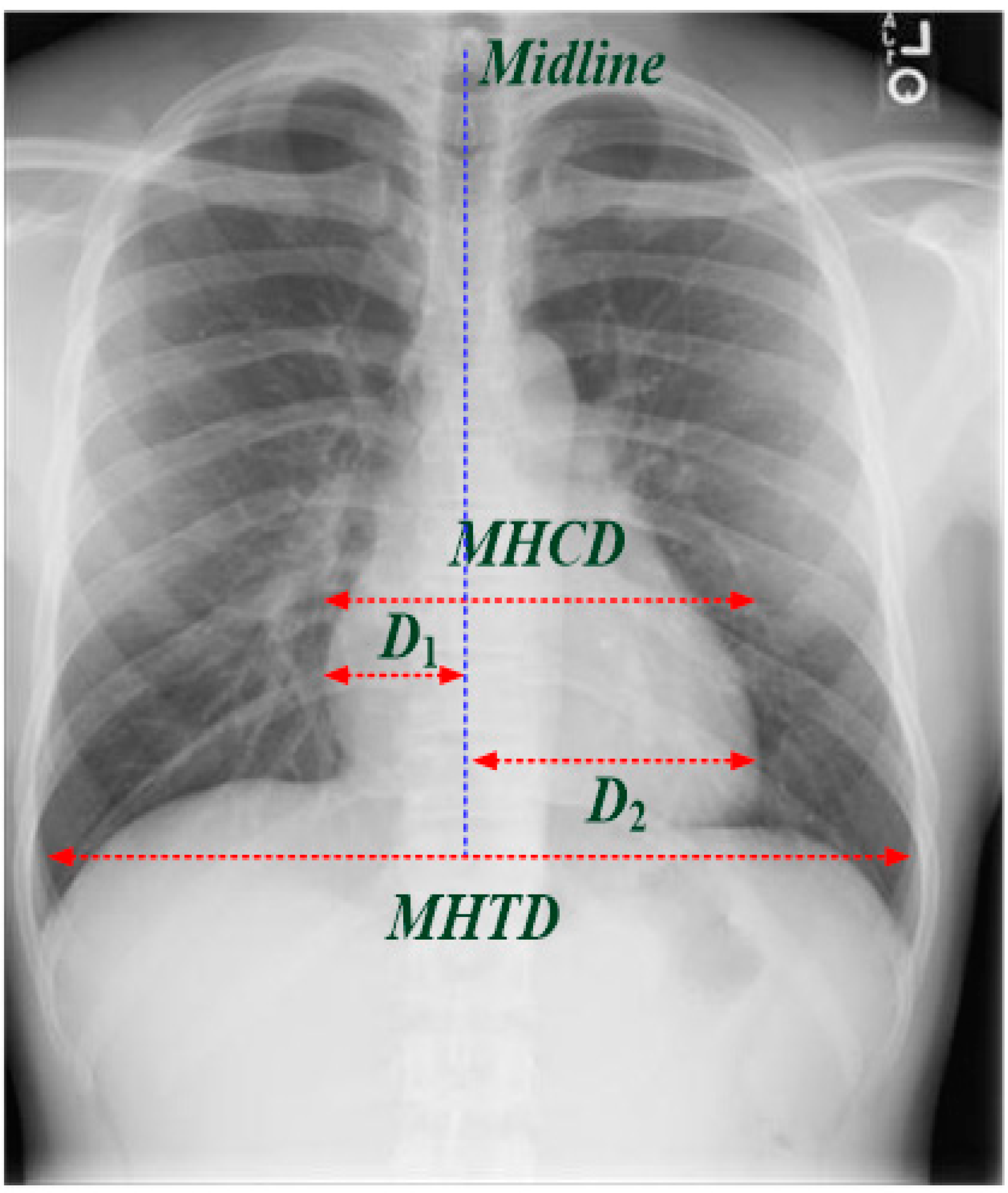
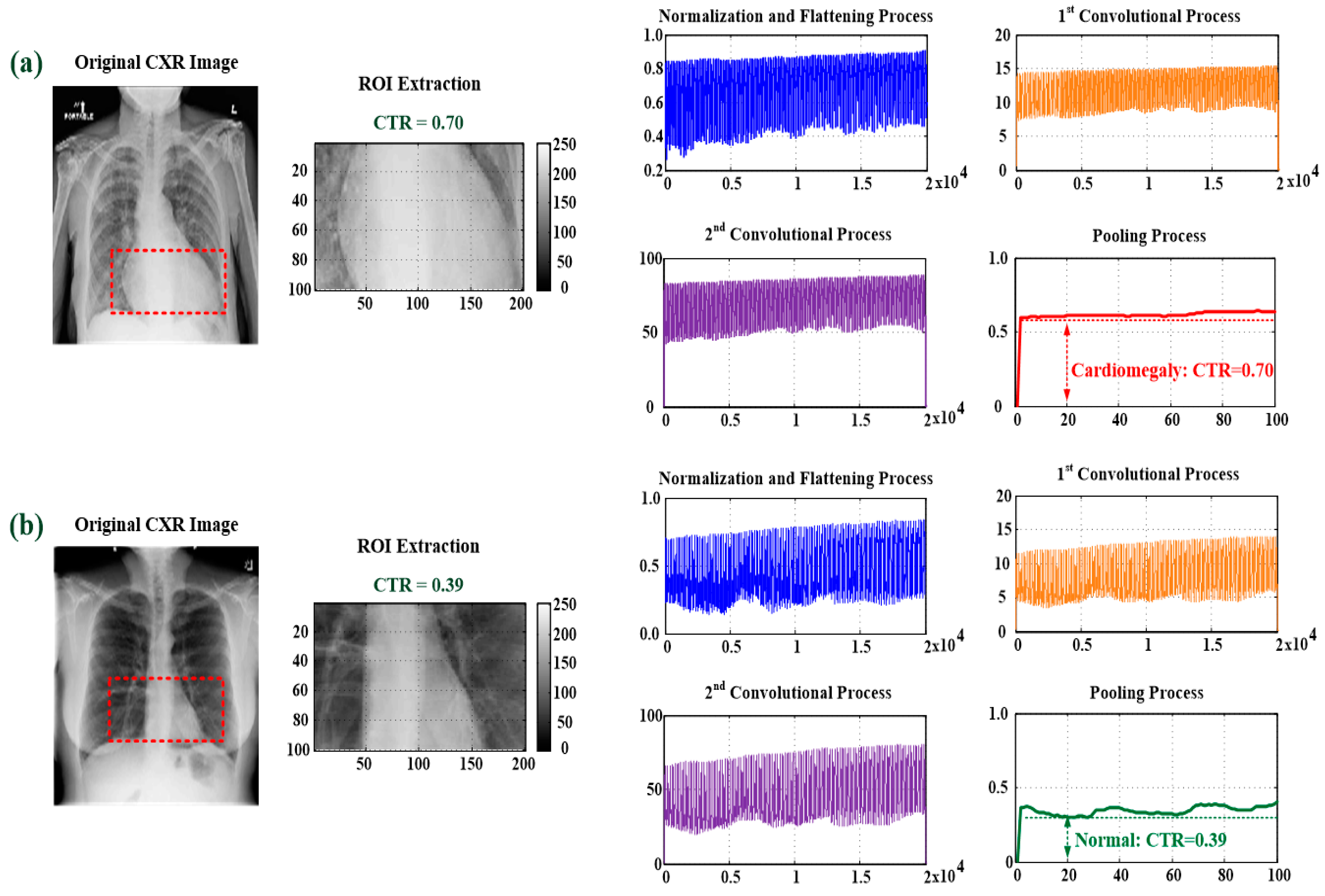
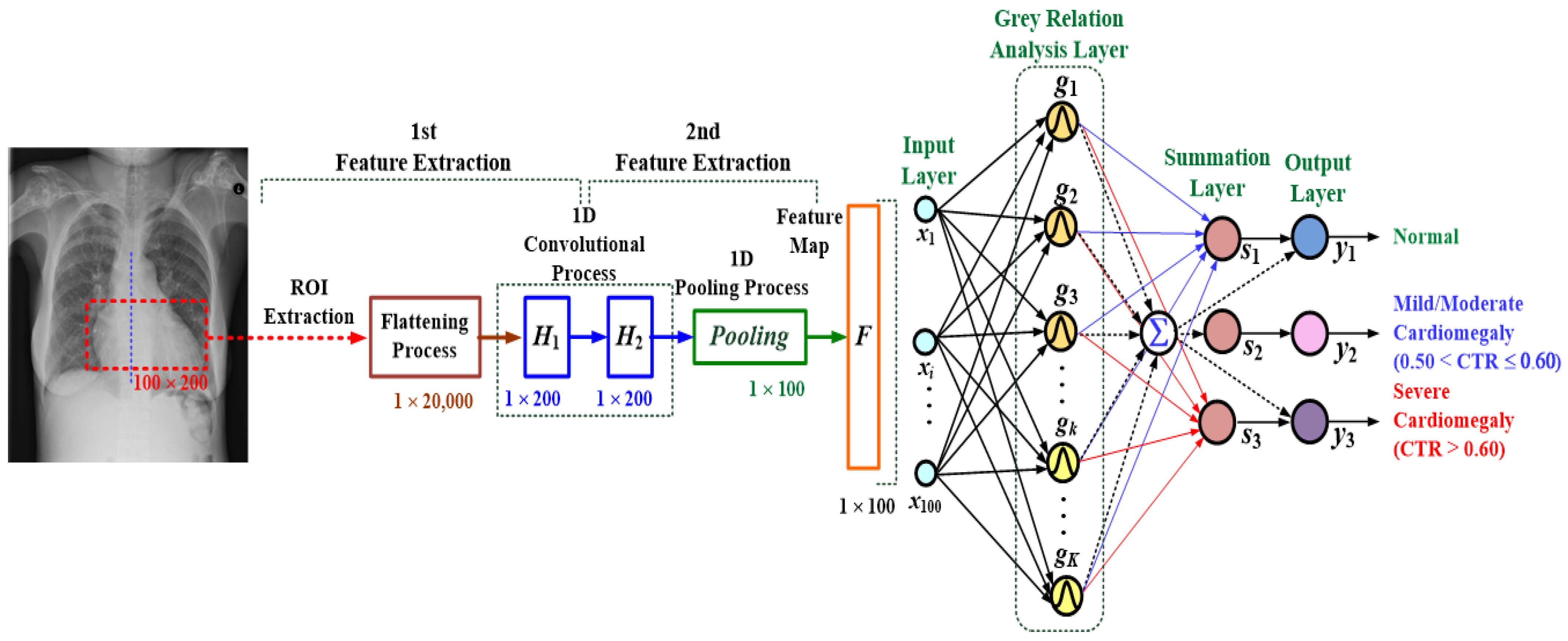


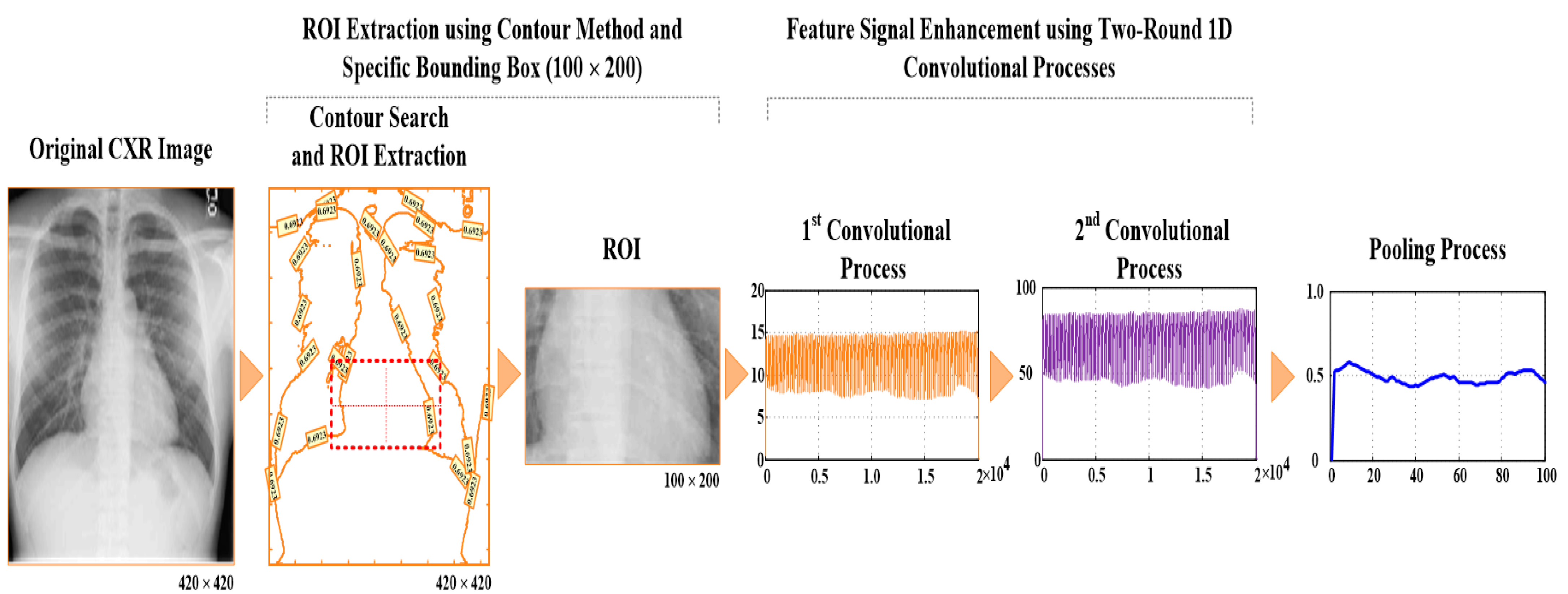
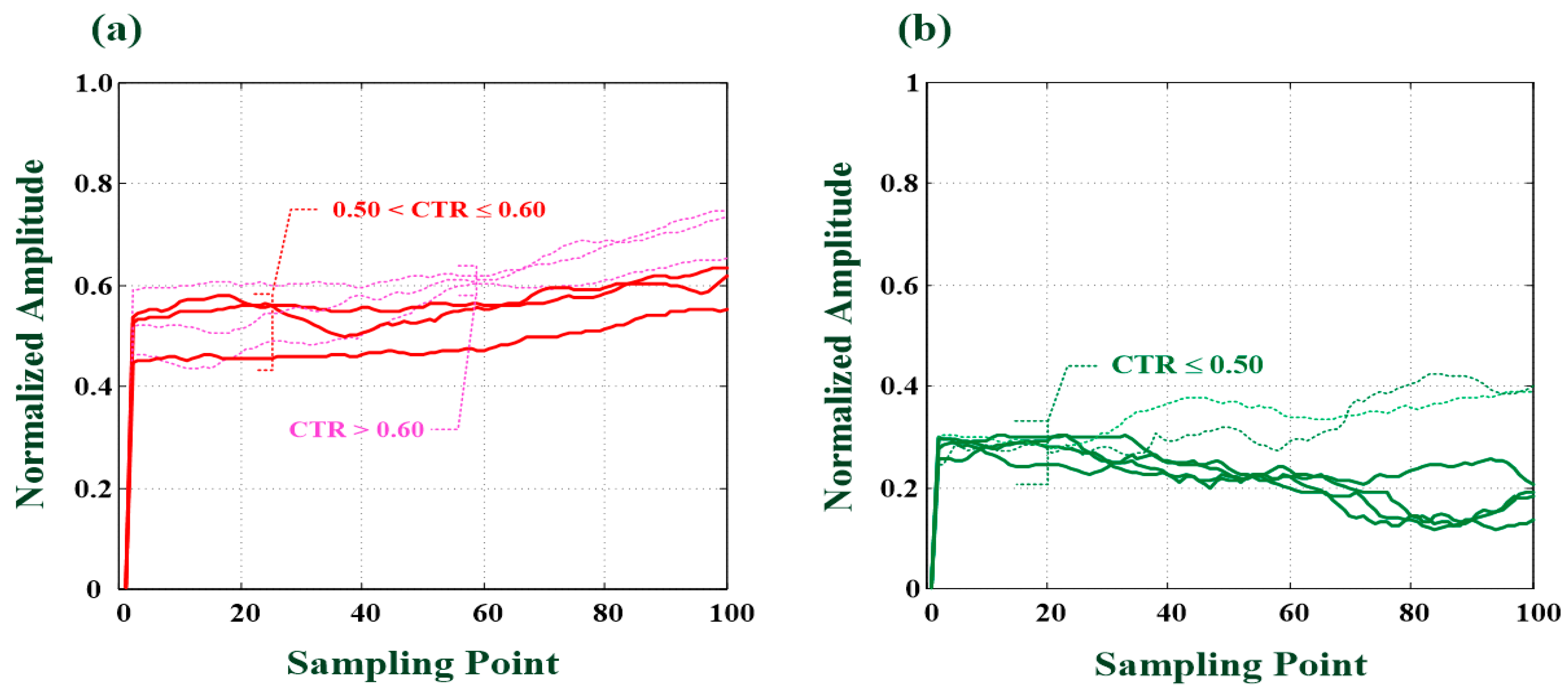
| Classifier | Layer Function | Manner | Feature Map |
|---|---|---|---|
| Multilayer 1D CNN-based Classifiers | Image Preprocessing | ROI Extraction and Flattening Process | FLATIx (1 × 20,000) |
| 1st Feature Extraction Layer | 1D Convolutional Process with Discrete Gaussian Function (Data Length of Convolution Mask, M = 200, Stride = 1) | X1 (1 × 20,000) | |
| 2nd Feature Extraction Layer | 1D Convolutional Process with Discrete Gaussian Function (Data Length of Convolution Mask, M = 25, Stride = 1) | X2 (1 × 20,000) | |
| Simplifying Feature Layer | 1D Pooling Processes (Stride = 200) | x (1 × 100) | |
| Classification Layer | Multilayer Connected Network: 100 input nodes, 100 GRA nodes, 4 summation nodes, 3 output nodes | Input Feature Signal (1 × 100) | |
| GRA Algorithm [20,25] | |||
| Multilayer 2D CNN-based Classifiers | Image Preprocessing | ROI Extraction | ROI Map (100 × 200) |
| 1st Feature Extraction Layer | 2D Kernel Convolutional Process (Stride = 1) | X1 (100 × 200) | |
| 2nd Feature Extraction Layer | 2D Kernel Convolutional Process (Stride = 1) nad Maximum Pooling Process (Stride = 2) | X2 (25 × 50) | |
| ×Flattening Layer | Flattening Process | x (1 × 1250) | |
| Classification Layer | Multilayer Connected Network: 1250 input nodes, 100 pattern nodes, 4 summation nodes, 3 output nodes | Input Feature Signal (1 × 1250) | |
| Learning Algorithm: Gradient Descent Method |
| Fold | Precision (%) | Recall (%) | Accuracy (%) | F1 Score | Average CTR for Normal | Average CTR for Cardiomegaly |
|---|---|---|---|---|---|---|
| 1 | 96.00 (TP: 48, FP: 2) | 96.00 (TP: 48, FN: 2) | 96.00 | 0.9600 | 0.4452 ± 0.0383 | 0.6556 ± 0.0725 |
| 2 | 100.00 (TP: 50, FP: 0) | 94.34 (TP: 50, FN: 3) | 97.00 | 0.9709 | 0.4476 ± 0.0399 | 0.5900 ± 0.0579 |
| 3 | 96.00 (TP: 48, FP: 2) | 96.00 (TP: 48, FN: 2) | 96.00 | 0.9600 | 0.4416 ± 0.1212 | 0.6496 ± 0.0754 |
| 4 | 100.00 (TP: 50, FP: 0) | 96.15 (TP: 50, FN: 2) | 98.00 | 0.9804 | 0.4336 ± 0.0323 | 0.6452 ± 0.07621 |
| 5 | 100.00 (TP: 50, FP: 0) | 100.00 (TP: 50, FN: 0) | 100.00 | 1.0000 | 0.4380 ± 0.0338 | 0.6320 ± 0.0786 |
| 6 | 96.00 (TP: 48, FP: 2) | 96.00 (TP: 48, FN: 2) | 96.00 | 0.9600 | 0.4320 ± 0.0336 | 0.5780 ± 0.0532 |
| 7 | 94.00 (TP: 47, FP: 3) | 95.92 (TP: 48, FN: 2) | 95.00 | 0.9494 | 0.4348 ± 0.0344 | 0.6296 ± 0.0778 |
| 8 | 96.00 (TP: 48, FP: 2) | 96.00 (TP: 48, FN: 2) | 96.00 | 0.9600 | 0.4384 ± 0.0342 | 0.6436 ± 0.0758 |
| 9 | 100.00 (TP: 50, FP: 0) | 100.00 (TP: 50, FN: 0) | 100.00 | 1.0000 | 0.4380 ± 0.0338 | 0.6384 ± 0.0779 |
| 10 | 96.00 (TP: 48, FP: 2) | 96.00 (TP: 48, FN: 2) | 96.00 | 0.9600 | 0.4280 ± 0.0312 | 0.6448 ± 0.0747 |
| Average | 97.40 | 96.64 | 97.00 | 0.9701 | 0.4377 | 0.6307 |
| Fold | Precision (%) | Recall (%) | Accuracy (%) | F1 Score | Average CTR for Normal | Average CTR for Cardiomegaly |
|---|---|---|---|---|---|---|
| 1 | 98.00 (TP: 49, FP: 1) | 98.00 (TP: 49, FN: 1) | 98.00 | 0.9800 | 0.4452 ± 0.0383 | 0.6556 ± 0.0725 |
| 2 | 100.00 (TP: 50, FP: 0) | 100.00 (TP: 50, FN: 0) | 100.00 | 1.0000 | 0.4476 ± 0.0399 | 0.5900 ± 0.0579 |
| 3 | 96.00 (TP: 48, FP: 2) | 96.00 (TP: 48, FN: 2) | 96.00 | 0.9600 | 0.4416 ± 0.1212 | 0.6496 ± 0.0754 |
| 4 | 98.00 (TP: 49, FP: 1) | 98.00 (TP: 49, FN: 1) | 98.00 | 0.9800 | 0.4336 ± 0.0323 | 0.6452 ± 0.07621 |
| 5 | 96.00 (TP: 48, FP: 2) | 100.00 (TP: 48, FN: 0) | 98.00 | 0.9796 | 0.4380 ± 0.0338 | 0.6320 ± 0.0786 |
| 6 | 100.00 (TP: 50, FP: 0) | 100.00 (TP: 50, FN: 0) | 100.00 | 1.0000 | 0.4320 ± 0.0336 | 0.5780 ± 0.0532 |
| 7 | 98.00 (TP: 49, FP: 1) | 98.00 (TP: 49, FN: 1) | 98.00 | 0.9800 | 0.4348 ± 0.0344 | 0.6296 ± 0.0778 |
| 8 | 96.00 (TP: 48, FP: 2) | 96.00 (TP: 48, FN: 2) | 96.00 | 0.9600 | 0.4384 ± 0.0342 | 0.6436 ± 0.0758 |
| 9 | 100.00 (TP: 50, FP: 0) | 100.00 (TP: 50, FN: 0) | 100.00 | 1.0000 | 0.4380 ± 0.0338 | 0.6384 ± 0.0779 |
| 10 | 96.00 (TP: 48, FP: 2) | 96.00 (TP: 48, FN: 2) | 96.00 | 0.9600 | 0.4280 ± 0.0312 | 0.6448 ± 0.0747 |
| Average | 97.80 | 98.20 | 98.00 | 0.9799 | 0.4377 | 0.6307 |
| Literature | Image Database | Method | Medical Purpose |
|---|---|---|---|
| [13] | NIH CXR Image Database (500 PA CXR Images) [5] | 2D U-Net and U-Net + Dense Conditional Random Field (CRF) | Lung and Heart Segmentation and CTR Estimation |
| [42] | JSRT Database (247 PA CXR Images) [7,8] and Montgomery dataset (138 PA CXR Images) [10] | Standard U-Net and XLSor Model [43] | Lung and Heart Segmentation and CTR Estimation |
| [44] | JSRT Database (247 PA CXR Images) [7,8] | X-RayNet #1 and X-ray Net #2 | Lung, Heart, and Clavicle Bones Segmentation and CTR Estimation |
| [45] | Faculty of Medicine Siriraj Hospital (7517 PA CXR Images) [45] | U-Net with VGG-16 encoding | Lung and Heart Boundary Location and CTR Estimation |
| [46] | NIH CXR Image Database (566 PA CXR Images) [5] | VGG-16 Model [47] | Cardiomegaly Classification (Cardiomegaly, No-Cardiomegaly) |
| [48] | ChestX-ray8 Batabase (1010 PA CXR Images) [6] | U-Net-based CNN Algorithm | Diagnosis and Precise Localization of Cardiomegaly Disease |
| [49] | Indiana Dataset (332 PA CXR Images) [49] | ImageNet (DCN) Binary Classification | Abnormality Detection and Localization |
| [50] | NIH CXR Image Database (1800 PA CXR Images) [5] | CNN-based ResNet [51] and Explainable Feature Map | Cardiomegaly Diagnosis |
| Proposed Method | NIH CXR Image Database (200 PA CXR Images) [5] | Two-round 1D Convolutional Processes + GRA-based Fully Connected Network | Cardiomegaly Level Screening (Normal, Mild/Moderate, and Severe) |
Publisher’s Note: MDPI stays neutral with regard to jurisdictional claims in published maps and institutional affiliations. |
© 2022 by the authors. Licensee MDPI, Basel, Switzerland. This article is an open access article distributed under the terms and conditions of the Creative Commons Attribution (CC BY) license (https://creativecommons.org/licenses/by/4.0/).
Share and Cite
Lin, C.-H.; Zhang, F.-Z.; Wu, J.-X.; Pai, N.-S.; Chen, P.-Y.; Pai, C.-C.; Kan, C.-D. Posteroanterior Chest X-ray Image Classification with a Multilayer 1D Convolutional Neural Network-Based Classifier for Cardiomegaly Level Screening. Electronics 2022, 11, 1364. https://doi.org/10.3390/electronics11091364
Lin C-H, Zhang F-Z, Wu J-X, Pai N-S, Chen P-Y, Pai C-C, Kan C-D. Posteroanterior Chest X-ray Image Classification with a Multilayer 1D Convolutional Neural Network-Based Classifier for Cardiomegaly Level Screening. Electronics. 2022; 11(9):1364. https://doi.org/10.3390/electronics11091364
Chicago/Turabian StyleLin, Chia-Hung, Feng-Zhou Zhang, Jian-Xing Wu, Ning-Sheng Pai, Pi-Yun Chen, Ching-Chou Pai, and Chung-Dann Kan. 2022. "Posteroanterior Chest X-ray Image Classification with a Multilayer 1D Convolutional Neural Network-Based Classifier for Cardiomegaly Level Screening" Electronics 11, no. 9: 1364. https://doi.org/10.3390/electronics11091364
APA StyleLin, C.-H., Zhang, F.-Z., Wu, J.-X., Pai, N.-S., Chen, P.-Y., Pai, C.-C., & Kan, C.-D. (2022). Posteroanterior Chest X-ray Image Classification with a Multilayer 1D Convolutional Neural Network-Based Classifier for Cardiomegaly Level Screening. Electronics, 11(9), 1364. https://doi.org/10.3390/electronics11091364










